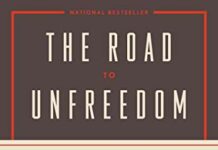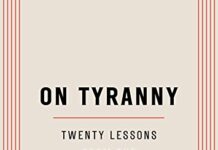
Ebook Info
- Published: 2012
- Number of pages: 562 pages
- Format: PDF
- File Size: 5.15 MB
- Authors: Timothy Snyder
Description
From the author of the international bestseller On Tyranny, the definitive history of Hitler’s and Stalin’s politics of mass killing, explaining why Ukraine has been at the center of Western history for the last century. Americans call the Second World War “the Good War.” But before it even began, America’s ally Stalin had killed millions of his own citizens—and kept killing them during and after the war. Before Hitler was defeated, he had murdered six million Jews and nearly as many other Europeans. At war’s end, German and Soviet killing sites fell behind the Iron Curtain, leaving the history of mass killing in darkness. Assiduously researched, deeply humane, and utterly definitive, Bloodlands is a new kind of European history, presenting the mass murders committed by the Nazi and Stalinist regimes as two aspects of a single story. With a new afterword addressing the relevance of these events to the contemporary decline of democracy, Bloodlands is required reading for anyone seeking to understand the central tragedy of modern history and its meaning today.
User’s Reviews
Reviews from Amazon users which were colected at the time this book was published on the website:
⭐Bloodlands by Timothy Snyder is a well-written, thoroughly-documented investigation into the Hell on Earth that was the “Bloodlands,” basically Poland, Belarus and the Ukraine during the era of Stalin and Hitler. Snyder’s attention to details – the individual deaths and the grotesque mass murder – focuses the reader’s attentions onto the quite literal “enormity” – the extreme evil or moral offensiveness – of which totalitarian societies – whether fascist or communist are capable.The fact that there were two monsters at work in the Bloodlands has come as something of a surprise to moderns who have tended to ignore the fact that the democratic West was allied with a psychopathic mass murderer of the first water. In his review of “Bloodlands” for Slate, Ron Rosenbaum, author of “Explaining Hitler: the Search for the Origins of His Evil”, commented that after reading the accounts of cannibalism during the Ukrainian Famine, which had been engineered by Stalin, he was “jolted me out of any illusion that meaningful distinctions could be made between Stalin and Hitler.” The fact that it took this book to jolt someone who had written a book about the evils out of Hitler into thinking about the evils of Stalin, speaks volumes about why Snyder’s book is a book that should be read by anyone with an interest in history, or, for that matter, by anyone who is interested in the mystery of human nature or of good and evil.Snyder does at least five things in this book that make it well worth reading.First, he breaks down the mostly artificial division that has been made between the experience of National Socialism and Communism for the people who were its chief victims. Most books consider one or the other – with the vast majority concerned only with the former, resulting in the naivety that Rosenbaum expressed in his review. As a consequence of the “fallacy of publicity” – i.e, that which gets the most publicity is most true – the victims of Stalinism, the hundreds of thousands of Poles who were shot for being Polish, have been reduced to non-existence.As Snyder points out, though, people didn’t experience one totalitarian system as if it were hermetically sealed from the other totalitarian system. They experienced them as either really bad “Hobson choices” – should one go East or West? It depended on whether you were Jewish or a Polish army officer, but most people didn’t get that choice. They were also experienced simultaneously, as Stalinist policies encouraged partisan actions – or the Warsaw Uprising – which resulted in Nazi reprisals, which permitted Stalin to watch his enemies exterminate the people most likely to oppose him in the future. Or they were experienced as almost seamless transitions from one system to the other, as, for example, when the Nazis took over the collective farms instituted by Stalin for the purpose of starving the peasants so that they could use those same farms to starve more peasants. Or, again, when the NKVD took over “Concentration Camp Warsaw” from the Nazis and used it to torture and murder members of the Polish Home Army after Poland was “liberated” from the Nazis.By treating the Bloodlands as a single entity between Hitler and Stalin, Snyder forces us to think about both Hitler and Stalin, and, thereby, fights our historical amnesia about the latter and reduces the former to a historical actor, rather than a mere caricature of evil.Second, Snyder tells an effective horror story. Snyder offers the statistics about Hitler and Stalin’s mass murders, but he recounts the individual stories that make up those numbers. It is one thing to hear about 20,000 murdered Polish army officers, quite another to hear about the wedding ring that one wanted to have returned to his wife. It is one thing to hear about the millions killed in the Holocaust, quite another to read of the child taken to fill a quota in the Warsaw Ghetto who pleaded, “I know that you are a good man, sir. Be so kind as to not take me away. My mama left for just a moment. She’ll be back in just a moment, and I won’t be there, be so kind as to not take me away.”These stories – like the stories of the cannibalism in the Ukraine during Stalin’s artificial famine – wear on the reader’s soul and cause one to wonder how such things could happen and whether human nature isn’t irreparably damaged.Third, Snyder corrects the popular image we have of the Holocaust. Like most people, my view was that the Holocaust involved the shipping of German Jews to concentration camps where they were gassed. I was surprised to learn that most Jewish victims of the Holocaust never saw a concentration camp; they were murdered by Einsatzgruppen east of the Molotov-Ribbentrop line. Most concentration camps were not death factories. The death factories emerged later in the war; mass killing of Jews started first east of the Molotov-Ribbentrop line, and then moved to the west where the death factories were developed. The death factories were developed, in part based, on the experience that the Nazis had garnered in murdering their own disabled citizens. Previously, I had some knowledge of the Einsatzgruppens’ activities and of the death factories, but I had no idea how they were integrated, or where the Holocaust began, or how long it took for the Holocaust to move West.Fourth, Snyder provided me with “big picture” ideas that helped to explain the apparent insanity of German war goals. For example, Snyder explains the German attack on the Soviet Union as part of the German war goal of making itself a continental power that contained within its borders the resources, including food, that would permit it to challenge the continental power of the United States and the oceanic power of Great Britain. So, while Operation Barbarossa seems like a daunting idea, it wasn’t per se insane.Likewise, the insanity of the Final Solution is explained by Snyder as being the only Nazi war aim after 1941 that the Nazis realized they could achieve. The Nazi war aim hadn’t originally been mass murder of the Jews, but vaguely involved re-settling the Jews somewhere, perhaps to the East. When such a resettlement was seen as not being possible, and with the slipping away of its other war goals, well, at least Himmler seemed to be able to produce some impressive statistics on the one war goal that the Nazis could achieve, mostly because – unlike the situation with respect to their war goals vis a vis the Soviet Unions – their victims didn’t have weapons. So, again, evil, vicious, inhuman, but “insane” only in the way that G.K. Chesterton defined “insanity,” namely not as someone who has lost their reason, but as someone who has lost everything but reason.Fifth, Snyder’s book is ultimately a great work of history, like Thucydides’ The Peloponnesian War. In the last chapter, Snyder tries to come to grips with how such evil things could have been possible. He essays some explanation about Hitler and Stalin’s genius at putting people in situations where they had to make immoral choices. He observes that “In 1941 in the western Soviet Union, SS officers, like NKVD officers a few years earlier, competed among themselves to kill more people and thus to demonstrate their competence and loyalty. Human lives were reduced to the moment of pleasure of a subordinate reporting to a superior.”Ultimately, the answer may be that there are no good answers, but to maintain our humanity, we shouldn’t pretend either that the stories didn’t happen or that the perpetrators of this evil were in no way like ourselves.
⭐I began reading this book as a tool for gaining a better understanding of what is going on in the Ukraine. There is no understanding of Ukraine’s current situation without understanding the cultural, social and criminal history laid out in this groundbreaking book. The key to Bloodlands is that it is based upon STATISTICS. This book is not based upon he said she said third party accounts. That is all that German histories of the Holocaust can be since the key point is that 95% of “Holocaust” deaths did not occur in or near Germany. They occurred in Eastern Europe, and the Allies never even reached the places where the killing happened. The Nazis were meticulous record keepers and they also had plenty of help from the local populations of the countries they invaded. Timothy Snyder brings a wealth of statistical evidence to bear on the subject of Genocide.Ukrainians are begging us today to free them from the Holodomor denying Russians. I hate to admit this, but I did not even understand what the Holodomor was. The “History” books sold me on the lie that Stalin was just doing what he had to do to establish the Soviet state and the Kulaks were a resistance group who had to be “dealt with”. And there is the bizarre conundrum that Stalin was right … the Kulaks and other dissenters who were shipped to the Gulag saved the Soviets by establishing industry in Siberia. We know that Stalin’s brutality saved Russia (barely) in World War 2. I have always thought that this indisputable fact justified whatever Stalin did. But I know now that Ukrainians can never forget the Holodomor genocide. And the Russians have made an inexcusable mistake in denying that the Holodomor occurred.It is crucial to understand the Historical facts presented here in light of the Ukrainian/Russian crisis.The Hitler vs. Stalin Genocide comparison quickly reveals that there was not one Holocaust, but many. The author’s premise that you need to compare genocides statistically in order to understand their true nature is clearly demonstrated. I must say that the planned starvation of the Ukrainian Holodomor exceeds by far any evil that can be conceived of. Stalin’s wife did the right thing in shooting herself in the heart as a response to what Stalin was doing to the Ukrainians. Bloodlands relies on statistics from documents made available since the fall of the Soviet empire to expose the reality of what actually happened. The statistical analysis is backed up by humanizing eyewitness accounts. The author reduced me to tears repeatedly with the sorrowful vignettes he selected to elucidate what the cold statistics meant.When I started reading Bloodlands I was attracted by some of the Horrific statements made in the Preface but it was not clear to me what Timothy Snyder meant when he said that in order to understand Genocide you need to compare one Genocide to other Genocides. But it very quickly became clear that the Hollywood version of the Nazi concentration camps was quite civilized compared to brutal Einsatzgruppen massacres like Babi Yar. 90% of Holocaust deaths involved the victims being rounded up, thrown in a pit and shot on the spot. It was just in your face DEATH with no death camps or sad family goodbyes. I have watched footage of the shootings and now understand why Jews were so passive and simply lay down in the pits to be slaughtered. They were completely dehumanized and facing atrocities on a scale where it was better to be shot and get it over with.Victims don’t write history but Timothy Snyder has done an eloquent job of speaking for them.Anyone who wants to understand this book needs to watch the actual murder footage on the Internet. (Einsatzgruppen, Holodomor, WW2 etc, It’s all out there. Sickening stuff, but inescapable.) There is no hiding behind propaganda and lies in today’s world … the footage that is out there confirms what Bloodlands says.An important aspect of Bloodlands is to bring the individuals who suffered such atrocities to life. In addition to being a great student of History Timothy Snyder is also a great writer. He has a keen sense of how spirtuality manifests itself in every day life. We clearly see the people who are being massacred in human terms. After looking at the stats we are presented with a heartbreaking story of a simple human being who was senselessly and needlessly slaughtered.Bloodlands makes it clear from the outset that the German accounts of the Holocaust represent an insignificant 2% of the victims. We are introduced to the other 98% along the way. And we are presented with many surreal scenarios that were commonplace. Eg. A Ukrainian man is captured by the invading Bolsheviks and serves in the Red Army. He runs away to join Nationalist Partisans, is captured by the Nazis and fights for them against the Bolsheviks. He is again captured by the Bolsheviks and is sent to Siberia. Seemingly bizarre examples demonstrate the ephemeral nature of survival in the Bloodlands.What is clear is that since the Bloodlands were occupied twice by the Bolsheviks and once by the Nazis the hapless victims had no chance of self determination whatsoever. And if they survived at all they were fortunate.In considering what the message of this book is, the author is clear in his intentions to avoid political intrigues and focus on the Bloodlands as a source of food that was essential for both the Nazis and the Bolsheviks. What is shown here is that when survival is on the line, there are no laws that can govern the atrocities people are forced to commit. Since we are approaching population levels where food is becoming scarce again we need to remember; Russians are not just posturing over the Ukraine, that is their breadbasket. We need to understand the history of this region and how dangerous Russian denial of Holodomor is. Ukrainians won’t accept that any more than Israelis will accept Holocaust deniers.At least the Holocaust is recognized by most people. Holodomor is not. We cannot comprehend how the Ukrainians must feel.One of the greatest atrocities in history and it’s not even recognized. This is what I learned from Bloodlands;The victims of these atrocities are still here with us. They are Ukrainians. World War 2 is not over.If Ukrainians feel the way I think they feel, then the current situation is a life/death struggle that cannot be settledpeacefully. Russian leaders need to learn a lesson from Pope John Paul II; he was the last person who needed to apologize for the massacre of Jews in Poland. Yet he did apologize because he recognized that it was a necessary step in the healing process.Timothy Snyder has big balls as a man in taking on this subject. It is clear to me why Historians simply want nothing to do with it. Reading the facts quite simply made me sick to my stomach. I can’t imagine how the author remained immersed in this material for years. As readers we are indebted to him for providing an undeniable resource regarding the Genocides in Eastern Europe. By providing statistical analysis backed up by concrete examples he refutes those who seek to replace Historical fact with Nationalist Revisionist History. Bloodlands brings to mind the old axiom: Those who cannot learn from history are destined to repeat it.
⭐This is a very well researched, highly detailed piece of work on the history of Central Europe from the end of the First World War till after the second. Mr Snyder illustrates in harrowing detail how virtually every ethnic group suffered some sort of persecution during this period, and also how so many came out with blood on their hands. As someone whose family heritage lies in this part of the world I found the book fascinating but also saddening.Page after page, the author reels off statistics of deaths in the hundreds of thousands and millions. If I had a criticism, it’s that this becomes relentless after a while. However I suppose it only reflects the relentless nature of the killing that took place.This book is a wake-up call and stark reminder of the ability of normal people to do evil when certain conditions come together. It shows that, under the thin veneer of civilisation, we are tribal at heart.Having been educated in the UK, I studied the first and second world wars at school, inevitably from a British perspective. This book presents those conflicts from a Central European (and particularly Polish) perspective. One discovers, for example, that rather than the First World War “ending in 1918”, the border wars that secured the inter-war Polish borders raged until 1922.I highly recommend this book to anyone interested in that period of history in that part of the world. But be warned; it is not a “light read” and is not for the squeamish!
⭐I just bought the paperback version of this. The topic is current and important, and I have valued Snyder’s other work.I am dismayed that the text (400+ pages plus an extensive bibliography) is presented in such a tiny font – my best estimate is 9pt). This does not promise to be easy reading, either in content or in legibility.I see there is a new edition on its way. I very much hope this important shortcoming will be rectified in the later version.
⭐It is somewhat obvious that since the Berlin Wall came down and the West has been able to access Soviet records of what the so-called communists under Stalin got up to domestically as well as what the Red Army found on their march to Berlin in WWII. New facts and new perspectives on the horrors of it all would emerge.And why not?What better way for the victims to be recognised and remembered? The innocents who have suffered because of the inbuilt ignorance and prejudice of the state proponents of hate. They deserve to have their story told and Snyder’s naming of the some of the victims is more than just a sentimental literary device – it is a form of justice of which he should be proud and of which the reader should be mindful.And what better person to evaluate it all than a non-European such as Timothy Snyder? His gaze is unrelenting, his conclusions comprehensive as well as humane. Snyder’s national objectivity is put to good use and is fair in its conclusions as he turns over the historical record.The sheer scale of human suffering – firstly explored under Stalin and then under Hitler from the years 1933 to 1945 – is simply staggering to the point of overwhelming. The people caught in the lands between Berlin and Moscow were subjected to what a can only be described as the ideological sausage machines dominating the West and East at the time.I have always been pro European but understood that Europe itself (Western to central Europe and right up to the Russian border) can be seen as one mass graveyard of human beings, of nations even. This is what has made the EU so important to me – I’d rather Europe be a place of fields of plenty for all (food) rather than killing fields as history points out to us it has been far too many times previously.It is also clear that the Europe before WWII was a place of inter-woven peoples that almost made the notion of statehood look somewhat ridiculous, even superfluous, artificial even. German speaking Czechs and Poles, Polish speaking Germans or Ukrainians – the sheer mixture of peoples and ethnicities (diversity) is staggering and thought provoking.It is nationalism itself that Snyder tells us is the culprit – nationalism is the unnatural, inhuman law at work here make no mistake about it. People will live where they can live – not where so-called leaders put imaginary lines on maps. They will speak the language they need to speak, till the good land that they can find and work with their neighbours to survive and worship their God as they see fit. To live and be happy.And then there are the Jews. Today Poland is seen as a Roman Catholic country but I had no idea that before WWII Poland was a major Jewish settlement – a centre for Jewry in Europe. Incredible to think when you look at it now. And as for Poland – it needs and deserves a thorough account of what happened during these times caught between these two titanic forces – Nazism and Soviet style cod communism.And now as others have noted (Keith Lowe in ‘The Fear & the Freedom’ or E.M Douglas ‘Orderly and Humane’ for example) we actually have less ethnic diversity (heterogeneity) in Europe and more homogeneous populations that seem ripe and easy prey for excessive and dangerous nationalism in countries that are now under pressure from migrants from Africa and the near East.It’s a heady brew – basically both Hitler and Stalin somehow live on in Europe in the scars created by the nations left behind by their polices after the conflict subsided.Did it ever really end? Perhaps not – perhaps we Europeans even now are walking with tigers? But how well do we understand this?Snyder is philosophical about this and sets an example of what we should be thinking when confronted with evaluating the likes of Hitler and Stalin. He repudiates revenge and an eye for an eye and says instead (p. 400):’To yield to this temptation, to find other people to be inhuman, is to take a step toward not away from, the Nazi position. To find other people incomprehensible is to abandon the search for understanding, and thus to abandon history.’Indeed. That is where we need to start with the most basic and simple question when confronted by potentially destructive ideology: Why?Highly recommended without reservation.
⭐This is a difficult read. The subject material is brutal. Our senses are anesthetized by the scale of the bloodshed. There is no hiding from the numbers and the consequential destruction.It is a subject that needs airing and discussing. Whose tragedy is it? The victims or more broadly humanities. Who counts the numbers, how are they counted by race/religion/country/class? Why are the numbers hidden or alternatively publicised for political purposes?The author deals expertly, calmly and without preaching. His book is well written and researched. It deserves to be widely read and understood.
⭐Truth in NumbersHaving admired Timothy Snyder’s reviews in NYRB, I looked forward to reading Bloodlands. I knew most of what would be in the book (MA thesis on the subject), but I was unprepared for his startlingly original analysis, which had me reading uninterrupted, huge chunks of this book in a sitting. It all comes down to the numbers – no one has ever related the numbers killed by the Germans and the Russians so intently to reveal the truth about the murder of 14 million people – not in combat, but in a specific part of Eastern Europe.Snyder unearths data and human stories which reveal the uncanny similarities between Stalin and Hitler, and some uncomfortable truths. It was Stalin who set the killing machine going in the Ukrainian collectivization in the 1930’s, starving over 3 millions, then moving on to the Great Terror, shooting over 700,000. Stalin killed his ‘own’ people in peace time, Hitler killed ‘lower races’ in wartime. Then, after the war, Stalin took up murder again, albeit on a smaller scale. That the two were partners between September 1939 and June 1941 and split the Bloodlands between themselves for a brief period – no relief to the locals, of course, is well known, but even in the episode, the revelations come thick and fast, particularly over Poland. When Hitler starts killing, his numbers went over 10 million – 5.7 million Jews, millions of Poles and so many others.Stalin killed to control the vast Soviet Union, mainly minorities who might object to his forced collectivization and industrial push. Hitler killed to expand his empire, and the Jews were his favourite victims. Hitler planned to kill over 40 million people in push east, but had to change tack in 1941 when it became clear that he would not defeat the Soviet Union – as early as November, 1941. Then the Final Solution for the Jews became annihilation.Snyder is in control of a vast body of material, writes sparingly and well, and his anecdotes always add colour and humanity. But it is his command of the big picture which makes this a great history book, one that changes perspectives – the more you learn, the more you feel you didn’t know before. Snyder is at his best when he shows how nations use numbers to justify policies, past and present, to write and re-write history. After the war, Stalin had to distance himself from the Jewish suffering, as Russian suffering had to be his focus – Russians were the victims and the winners – no room for the Jews in the Great Patriotic War.This is a great, purposeful work that others will be studying for many years to come. The madness of Stalin and Hitler is not discussed in great detail – it is their behaviour and its consequences that fill these pages. Top drawer for historians.
Keywords
Free Download Bloodlands: Europe Between Hitler and Stalin in PDF format
Bloodlands: Europe Between Hitler and Stalin PDF Free Download
Download Bloodlands: Europe Between Hitler and Stalin 2012 PDF Free
Bloodlands: Europe Between Hitler and Stalin 2012 PDF Free Download
Download Bloodlands: Europe Between Hitler and Stalin PDF
Free Download Ebook Bloodlands: Europe Between Hitler and Stalin




